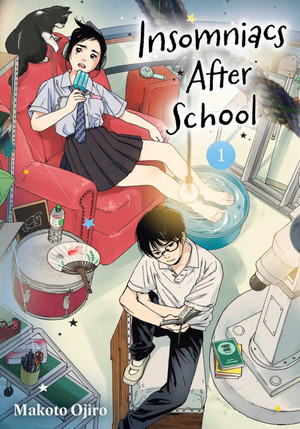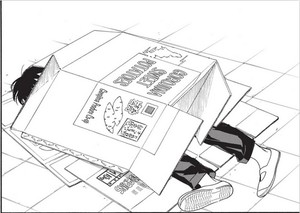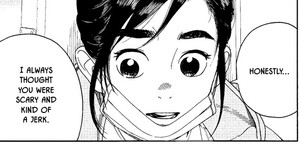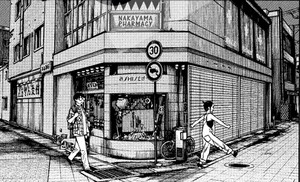The Spring 2023 Manga Guide
Insomniacs After School
What's It About?

Years ago, there was an astronomy club, but after a series of tragedies befell the members, the club was shut down, and the observatory turned into a storeroom. Rumors of it being haunted keep people away from it, but when Ganta Nakami, who suffers from insomnia, finds it, he realizes that it's the perfect place for a nap. When he realizes that his classmate Magari is already using it as a safe space, the two band together to preserve their space and find a little comfort in the night.
Insomniacs After School has a story and art by Makoto Ojiro, with English translation by Andria Cheng with lettering and touch-up by Inori Fukuda Trant. Viz released the first volume both digitally and physically on March 21.
Is It Worth Reading?

Rebecca Silverman
Rating:
Although it deals with a serious issue, it is more invested in developing relationships between its two leads and helping them to find a point of balance in their lives. The two are barely acquainted members of the same class, not really interacting until preparations for the school festival send Nakami up to the old astronomy club observatory. School legend has it that the astronomy club was disbanded some years ago after a series of tragedies befell its five members: one girl killed herself, and her ghost then apparently caused the deaths of the three boys in the club. At that point the school shut down the club and ceased to use the observatory for its intended function, repurposing it as a storage room. If this sounds like a slightly suspect reason for the school to stop using expensive equipment in a space dedicated to it, you're right, and there's a good chance that there isn't any truth in the school legend. When Nakami arrives at the observatory, he discovers that his classmate Magari is already there, and she admits to having fabricated the story of the school ghost. Whether this means that the entirety of the story is false or whether the school has the astronomy club when it ran out of students interested in the subject isn't really explored, and the possibility that something terrible did happen to that past astronomy club remains open. But for Nakami and Magari the empty club space becomes a refuge, the one place where they can finally close their eyes and get some sleep.
The book is an interesting combination of both interior and exterior storylines, with the surface actions of their day-to-day lives masking their burgeoning friendship and the importance that the observatory has for them. The inclusion of a potentially stray cat who hangs around the school seems to be a metaphor for the teens themselves; the cat also finds a home in the observatory and is something of an enigma to everyone around it, although they appear more willing to attempt to understand the cat then to understand Nakami, who has a reputation for being surly and nitpicky if not outright mean. There are adults around who might be willing to help them (at least at Nakami's home, where it appears that his father may not be 100% present), but neither of them is quite ready to take that next step. It feels like a very real approach to how high schoolers handle their mental health needs, and the possibility that there really may have been something tragic behind the closing of the astronomy club in the first place adds a layer of mystique to the story.
Insomniacs After School is set up to be a layered story. With its expressive faces and body language and believable actions by its teenage characters, there is some definite potential here, even if the slow pace risks turning some readers away.

Christopher Farris
Rating:
There are key components to spell success for a story like Insomniacs After School, especially keeping up with its contemporaries like Call of the Night. Those would be the manga's depiction of scenery and nighttime atmosphere, as well as the more esoteric communication of those all-important Vibes inherent to the wide-awake nighttime experience. Without any supernatural twists or major conflicts to get by on, this sleepytime slice-of-life production lives or dies on the appeal of its characters, and how and where we see them inhabit their liminal mental states.
Luckily for Insomniacs After School, it's a manga that has a handle on those important stylistic components. The characters feel like appreciably real, goofy kids, with our main duo of sleepy-beepers in Nakami and Magari standing out as leads well. I enjoy the simple definitions of them suffering from the same insomnia issue yet taking different approaches to deal with it, Nakami reaching out to a friend while Magari isolates herself in the observatory (complete with a Scooby-Doo-ass cover-up ghost story to keep others out of it). These make for neat mirrors of their social situations in daytime life and create an obvious connection point that allows them to meet and become sleep-dependent, as they do. They're depicted with a modest art style that can feel quite grounded at times but isn't afraid to indulge in wonderfully cartoonish reactions when needed. It's all in the expertly expressive eyes, with Makoto Ojiro definitely having a handle on it.
Insomniacs After School is a story less about setting up an outlet for philosophical discussions spurred by navigating the unoccupied nighttime, and more about people finding a place where they can, at last, be comfortable enough with themselves to get to know each other. That former limitation is on display in the chapter where Nakami and Magari actually attempt a nighttime excursion, wherein the atmosphere of the calm, abandoned dark isn't quite as well communicated as the cozy, constructed environs of the observatory. The reader winds up much happier for the duo once they're officially allowed that place after joining the astronomy club, even as that necessitates me sitting through an unbelievable scene where two high schoolers struggle to find and identify the moon in the sky. I can ironically see this one being too low-key for some in a way that will put them to sleep. But for my part, it wielded a strong ability to portray those vibes, to draw me into the low-fi chill beats to study and relax of an observatory filled with the sound of rain, breathing, and heartbeats.

Jean-Karlo Lemus
Rating:
This is hands-down the best thing I've had the chance to read for the Preview Guide. Insomnia is a debilitating condition, and it's very painful for folks to talk about since there's so much misinformation. Nakami and Magari both suffer from insomnia which ruins their daily lives. While the story frames the abandoned observatory at their school as the thing that helps them relax, what really unites them is each other.
This is a manga about finding a kindred soul who illuminates all the places you didn't know were there. Nakami and Magari bicker and romp together, They even sleep with their heads on each other's shoulders, not unlike a pair of cats. While I'd like to claim that this is a story of just physical intimacy divorced from romance, the tone definitely suggests that the relationship between these two teenagers means a lot more.
The artwork definitely helps to sell this. The daytime at school is flat, with no shadows and boring hallways. It's at nighttime when the world truly comes alive: the quiet town is at its richest and most detailed, and the ordinary things in daylight are paradoxically in greater focus at night. The sky is vivid with stars and clouds for Nakami and Magari to explore freely, provided they don't decide to take a catnap together.
This manga feels special. It's one of those few that you won't forget so soon. I strongly recommend this to anyone.

MrAJCosplay
Rating:
Insomnia sucks. I suffer from it occasionally due to a variety of different factors that I don't even want to remotely get into but trust me when I say that it sucks. It's also an embarrassing thing to talk about, especially when you're young and people expect you to only deal with certain problems in your day-to-day life. Insomniacs After School is about two young teenagers who just want to find a place where they can escape from those issues. What starts off as just finding an isolated area for the two to finally get some sleep in order to soothe their everyday irritation, slowly turns into a rather organic, slice-of-life romance that is more than happy with taking its time. There's definitely a more grounded component to this story, partially thanks to its character designs and presentation being far less exaggerated than what you would typically see in a lot of other manga but I think that's to the story's benefit. It uses a very specific issue as a catalyst for two people to bond, showing that sometimes you just need to find a person that understands what you're going through in order to feel safe and comforted. As long as you're with that person, any place can be a safe haven and even the most mundane things can feel exciting again. I do think the book is a little too slow at times and there are moments where I felt like there should've been more development given the amount of time that seems to lapse in this volume but when my biggest complaint about a story is that I wish there was more of it, then you could argue that is hardly a problem at all.
discuss this in the forum (33 posts) |
this article has been modified since it was originally posted; see change history
back to The Spring 2023 Manga Guide
Seasonal homepage / archives